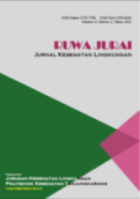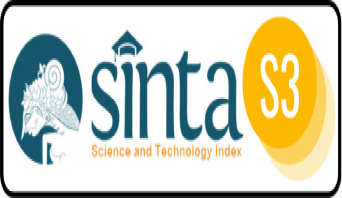Utilization of Oil Palm Shell Waste (Elaeis guineensis Jacq) into Activated Charcoal
DOI:
https://doi.org/10.26630/rj.v19i1.4886Keywords:
Oil palm shell, Activated charcoal, Elaeis guineensisAbstract
Oil palm shells are solid waste generated from the palm oil industry. The processing of oil palm shells into activated charcoal has not yet been optimized, despite the high demand for activated charcoal in various industries, such as desulfurization in gas purification and LNG processing, as well as filtration processes. Therefore, the quality of activated charcoal depends on the carbonization and activation process. This study aims to determine whether oil palm shells can be converted into activated charcoal using H₃PO₄ as an activating agent at concentrations of 8%, 9%, and 10%, and soaking times of 20, 22, and 24 hours, by the Indonesian National Standard (SNI) for activated charcoal. This study employs a pre-experimental, one-shot case study design. The treatment applied includes the independent variables of H₃PO₄ concentrations (8%, 9%, 10%) and soaking durations (20, 22, 24 hours). The carbonization temperature for all samples was 450–500°C for 0.5 hours. The dependent variable is the resulting activated charcoal powder that meets SNI standards. Activated charcoal with an 8% H₃PO₄ concentration and a 20-hour soaking time yielded the following results: a moisture content of 10.64%, an ash content of 2.66%, and a calorific value of 3,678.43 cal/g. With 9% H₃PO₄ and 20-hour soaking: 9.88% moisture, 2.95% ash, and 4,955.1 cal/g. With 10% H₃PO₄ and 20-hour soaking: 8.21% moisture, 3.53% ash, and 6,190.58 cal/g. The best result, according to SNI 1683-2021 "Wood Charcoal", was achieved at 24 hours of soaking and a 10% H₃PO₄ activator concentration, with the following values: 8.21% moisture, 3.53% ash, and 6,190.58 cal/g calorific value. It is therefore recommended for activated charcoal production.
References
Agustina, S. (2004). Study on the Re-Activation Process of Used Activated Carbon for Glycerin Adsorption by Heating Method (Master's Thesis). Graduate School, Bogor Agricultural University, Bogor. https://doi.org/10.24817/jkk.v0i0.3575
Allorerung, D., et al. (2008). Opportunities for Coconut Development in Health Products. Center for Agricultural Innovation Development, Plantation Research and Development Center, Bogor.
Andi, H., Norsamsi, et al. (2014). Study on the Utilization of Palm Oil Waste. Faculty of Engineering, Lambung Mangkurat University, South Kalimantan.
Arbi, Y., et al. (2016). Utilization of Oil Palm Shell Waste into Charcoal Briquettes as Alternative Fuel. Padang State University.
Budiono, A., et al. (2009). Effect of Phosphoric Acid Activation on Coconut Shell for Phenol Adsorption. Department of Chemistry, Diponegoro University.
Hendra, D. (2006). Production of Activated Carbon from Oil Palm Shells and Sawdust Mixtures. Researcher at the Forest Products Research and Development Center, Bogor. https://doi.org/10.20886/jphh.2006.24.2.117-13
Donda, M.S., Silalahi, M., & Francisco, Y. (2019). Utilization of Oil Palm Shells as Activated Carbon in Used Cooking Oil Adsorption. Polytechnic of Industrial Chemical Technology, Medan.
Fauzi, Y., et al. (2012). Palm Oil. Jakarta: Penebar Swadaya.
Hasni, H., et al. (2014). Production of Activated Carbon from Oil Palm Shells Using Water as an Activator to Analyze Proximate, Iodine Number, and Yield. Faculty of Mathematics and Natural Sciences, University of Riau, Pekanbaru. https://media.neliti.com/media/publications/189895-ID-pembuatan-karbon-aktif-dari-cangkang-kel.pdf
Haryono, B., et al. (2013). Oil Palm. Jakarta: PT Trisula Adisakti.
Hendra, D., & Pari, G. (1999). Production of Activated Carbon from Empty Palm Oil Bunches. Bulletin of Forest Products Research, 17(2), 133–122. https://media.neliti.com/media/publications/179413-ID-pembuatan-arang-aktif-dari-tandan-kosong.pdf
Hutahaean. (2007). Chemical Composition Test Results of Palm Shell Ash. State Islamic University Sunan Ampel, Surabaya.
Kurniati, E. (2008). Utilization of Oil Palm Shells as Activated Carbon. UPN Veteran, East Java. Journal of Engineering Science Research, 8(2), 96–103. https://eprints.upnjatim.ac.id/2805/2/JURNAl_ELLY_4.pdf
Kurnia, O. (2014). Production of Activated Carbon from Oil Palm Shells Using HCl, NaOH, and NaCl Activators. Sriwijaya State Polytechnic, Palembang. http://eprints.polsri.ac.id/962/1/COVER%20DAN%20ISI.pdf
Lempang, M. (2014). Production and Uses of Activated Carbon. Makassar Forestry Research Center, South Sulawesi. https://doi.org/10.20886/buleboni.5041
Meisrilestari, Y., Khoma, R., & Wijayanti, H. (2013). Production of Activated Carbon from Oil Palm Shells through Physical, Chemical, and Physico-Chemical Activation. Department of Chemical Engineering, Lambung Mangkurat University. https://ppjp.ulm.ac.id/journal/index.php/konversi/article/view/136
Muamar, A. (2021). Production and Utilization of Activated Carbon from Agricultural Waste. Faculty of Science and Technology, Ar-Raniry State Islamic University, Banda Aceh. https://repository.ar-raniry.ac.id/id/eprint/16355/
Sembiring, M.T., & Sinaga, T.S. (2003). Activated Carbon: Introduction and Production Process. Faculty of Engineering, University of North Sumatra, Medan.
Ratmingsih, N.M. Experimental Research in Second Language Learning. Faculty of Languages and Arts, Department of English Education, UNDIKSHA, Singaraja. https://doi.org/10.23887/prasi.v6i11.6816
Ministry of Industry. (2007). Overview of the Palm Oil Industry. https://doi.org/10.17358/jma.9.3.194-201
Sudrajat, R., & Pari, G. (2011). Activated Carbon Book. Jakarta.
Rahman, A. (2020). Efficiency Analysis of Palm Shell Activated Carbon as a Replacement Filter Media. Islamic University of Riau, Pekanbaru. http://repository.uir.ac.id/id/eprint/8073
Rindayatno. (2021). Charcoal Production Handbook. Faculty of Forestry, Mulawarman University.
Risky, S. (2018). Utilization of Palm Shell Activated Carbon to Reduce Peroxide Number in Used Cooking Oil. Politeknik Kesehatan Kemenkes Medan.
Sonhaji, A. (2008). How to Make Charcoal. Bandung: CV Gaza Publishing. https://doi.org/10.61233/zijec.v3i1.87
Sudibandriyo, M., & Lydia. (2011). Surface Area Characteristics of Activated Carbon from Bagasse Using Chemical Activation. Indonesian Journal of Chemical Engineering, 10(3), 149–156.
Sugiyono. (2007). Business Research Methodology. Jakarta: PT Gramedia.
Tutik, M., & Faizah, H. (2001). Chemical Activation of Coconut Shell Charcoal Using ZnCl₂, KCl, and HNO₃ Solutions. Department of Chemical Engineering, UPN, Yogyakarta. https://eprints.upnjatim.ac.id/2805/2/JURNAl_ELLY_4.pdf
Yoshizawa, N., Yoshio, Y., & Minoru, S. (1999). Structural Characteristics of Charcoal Material with Low Crystallinity Using Data Analysis Methods. National Institute for Resources and Environment.
Downloads
Published
How to Cite
Issue
Section
License
Copyright (c) 2025 Ruwa Jurai: Jurnal Kesehatan Lingkungan

This work is licensed under a Creative Commons Attribution-NonCommercial 4.0 International License.

Ruwa Jurai: Jurnal Kesehatan Lingkungan is licensed under a Creative Commons Attribution-NonCommercial 4.0 International License.
Authors who publish with this journal agree to the following terms:
- Authors retain copyright and grant the journal right of first publication with the work simultaneously licensed under a Creative Commons Attribution-Non Commercial License that allows others to share the work with an acknowledgment of the work's authorship and initial publication in this journal.
- Authors are able to enter into separate, additional contractual arrangements for the non-exclusive distribution of the journal's published version of the work (e.g., post it to an institutional repository or publish it in a book), with an acknowledgment of its initial publication in this journal.
- Authors are permitted and encouraged to post their work online (e.g., in institutional repositories or on their website) prior to and during the submission process, as it can lead to productive exchanges, as well as earlier and greater citation of published work.









